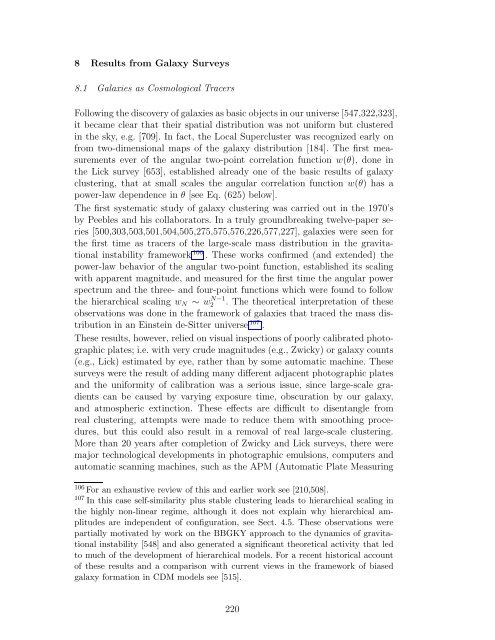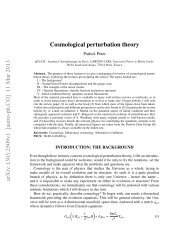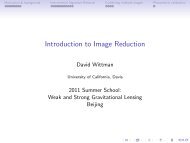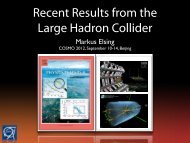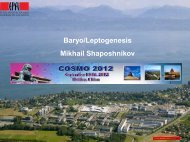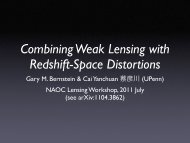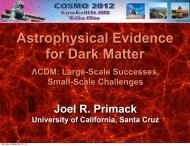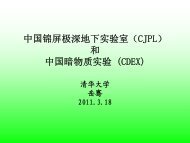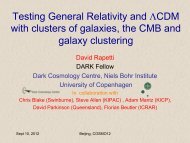Large-Scale Structure of the Universe and Cosmological ...
Large-Scale Structure of the Universe and Cosmological ...
Large-Scale Structure of the Universe and Cosmological ...
You also want an ePaper? Increase the reach of your titles
YUMPU automatically turns print PDFs into web optimized ePapers that Google loves.
8 Results from Galaxy Surveys<br />
8.1 Galaxies as <strong>Cosmological</strong> Tracers<br />
Following <strong>the</strong> discovery <strong>of</strong> galaxies as basic objects in our universe [547,322,323],<br />
it became clear that <strong>the</strong>ir spatial distribution was not uniform but clustered<br />
in <strong>the</strong> sky, e.g. [709]. In fact, <strong>the</strong> Local Supercluster was recognized early on<br />
from two-dimensional maps <strong>of</strong> <strong>the</strong> galaxy distribution [184]. The first measurements<br />
ever <strong>of</strong> <strong>the</strong> angular two-point correlation function w(θ), done in<br />
<strong>the</strong> Lick survey [653], established already one <strong>of</strong> <strong>the</strong> basic results <strong>of</strong> galaxy<br />
clustering, that at small scales <strong>the</strong> angular correlation function w(θ) has a<br />
power-law dependence in θ [see Eq. (625) below].<br />
The first systematic study <strong>of</strong> galaxy clustering was carried out in <strong>the</strong> 1970’s<br />
by Peebles <strong>and</strong> his collaborators. In a truly groundbreaking twelve-paper series<br />
[500,303,503,501,504,505,275,575,576,226,577,227], galaxies were seen for<br />
<strong>the</strong> first time as tracers <strong>of</strong> <strong>the</strong> large-scale mass distribution in <strong>the</strong> gravitational<br />
instability framework 106 . These works confirmed (<strong>and</strong> extended) <strong>the</strong><br />
power-law behavior <strong>of</strong> <strong>the</strong> angular two-point function, established its scaling<br />
with apparent magnitude, <strong>and</strong> measured for <strong>the</strong> first time <strong>the</strong> angular power<br />
spectrum <strong>and</strong> <strong>the</strong> three- <strong>and</strong> four-point functions which were found to follow<br />
<strong>the</strong> hierarchical scaling wN ∼ w N−1<br />
2 . The <strong>the</strong>oretical interpretation <strong>of</strong> <strong>the</strong>se<br />
observations was done in <strong>the</strong> framework <strong>of</strong> galaxies that traced <strong>the</strong> mass distribution<br />
in an Einstein de-Sitter universe 107 .<br />
These results, however, relied on visual inspections <strong>of</strong> poorly calibrated photographic<br />
plates; i.e. with very crude magnitudes (e.g., Zwicky) or galaxy counts<br />
(e.g., Lick) estimated by eye, ra<strong>the</strong>r than by some automatic machine. These<br />
surveys were <strong>the</strong> result <strong>of</strong> adding many different adjacent photographic plates<br />
<strong>and</strong> <strong>the</strong> uniformity <strong>of</strong> calibration was a serious issue, since large-scale gradients<br />
can be caused by varying exposure time, obscuration by our galaxy,<br />
<strong>and</strong> atmospheric extinction. These effects are difficult to disentangle from<br />
real clustering, attempts were made to reduce <strong>the</strong>m with smoothing procedures,<br />
but this could also result in a removal <strong>of</strong> real large-scale clustering.<br />
More than 20 years after completion <strong>of</strong> Zwicky <strong>and</strong> Lick surveys, <strong>the</strong>re were<br />
major technological developments in photographic emulsions, computers <strong>and</strong><br />
automatic scanning machines, such as <strong>the</strong> APM (Automatic Plate Measuring<br />
106 For an exhaustive review <strong>of</strong> this <strong>and</strong> earlier work see [210,508].<br />
107 In this case self-similarity plus stable clustering leads to hierarchical scaling in<br />
<strong>the</strong> highly non-linear regime, although it does not explain why hierarchical amplitudes<br />
are independent <strong>of</strong> configuration, see Sect. 4.5. These observations were<br />
partially motivated by work on <strong>the</strong> BBGKY approach to <strong>the</strong> dynamics <strong>of</strong> gravitational<br />
instability [548] <strong>and</strong> also generated a significant <strong>the</strong>oretical activity that led<br />
to much <strong>of</strong> <strong>the</strong> development <strong>of</strong> hierarchical models. For a recent historical account<br />
<strong>of</strong> <strong>the</strong>se results <strong>and</strong> a comparison with current views in <strong>the</strong> framework <strong>of</strong> biased<br />
galaxy formation in CDM models see [515].<br />
220


